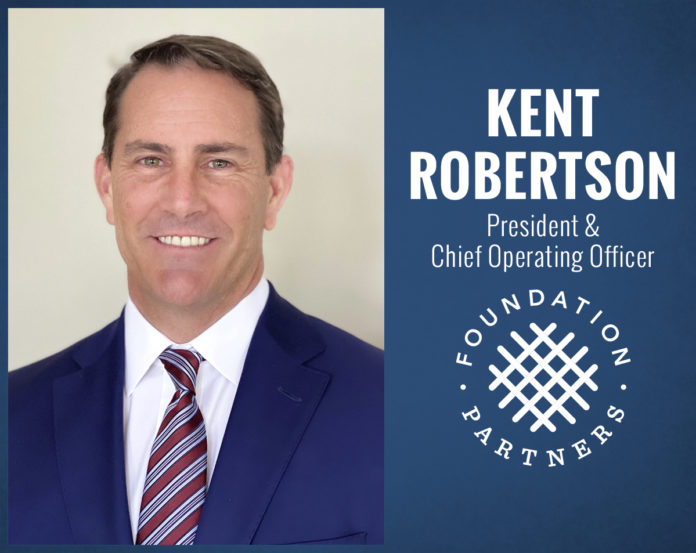By Leader Editor Kara Apel
Foundation Partners Group experienced record growth last year, including its most recent acquisition of Baldwin Brothers in Central and Southwest Florida.
In 2021, the company acquired over 50 locations and now serves more than 115,000 families annually through its 215 locations.
The Funeral Leader recently spoke with Kent Robertson, president and chief operating officer* of Foundation Partners Group, to learn more about the company’s strategy moving forward and to hear his perspective on the future of the profession.
(*Note: Since the publication of this article, Robertson has been promoted to CEO. Read more here.)
Below is a Q&A with Robertson conducted by Editor Kara Apel.
In your opinion, what does the future of cremation services look like?
If you look at history, you can see a little bit of the future. I think the mix shift that we’ve seen over the last five to 10 years, is going to continue. If you look at the CANA and NFDA studies, consumer opinion supports this as well. So, there is no question that as this trend moves across the U.S., we will continue to see cremation adoption accelerating.
The other thing that we’re going to continue to see, and I believe COVID had a lot to do with it, is a more educated consumer because people have more resources available to get smarter about what cremation or deathcare really is all about.
The last thing is this … why is cremation catching on? There are myriad reasons, but one is that it’s a simple solution for people to get their minds around, as far as how they make an arrangement, how they schedule a service, etc.
How do Foundation Partners firms handle cremation services differently? What makes them unique?
We try to meet each family where they are, whatever their situation is, whether it’s in their living room, in our funeral home or online. The main thing, first and foremost, is trying to be more contemporary and offering simple, transparent solutions so families can understand what we’re doing and what they’re getting.
The other big piece of it is just making sure that the team members talking with those families are well-versed in all the options. It’s really about being the expert, right?
As a profession, I think we all do a really great job of that, and at Foundation Partners we invest quite a bit of time to make sure our funeral directors and our team members know how to talk with people and listen to really understand their needs.
I know you kind of touched on some of the trends you’re seeing, but are there any specifically that you think other people in the industry need to know about in relation to cremation?
I can think of three that are interesting right now.
One trend is outsourcing … generally speaking, funeral homes that we’ve been talking to are doing more and more outsourcing. It used to be just basic things like websites and accounting. Now, some firms are starting to outsource more services, like transfer logistics, cremations, and embalming. I think part of that’s driven by staff shortages in the industry as folks try to figure out how to give relief to their employees. So, we’re seeing a big shift toward more outsourcing of back-of-house type functions.
Another growing trend is more price sensitivity among consumers. They’re just more price-conscious today. We’ve done some consumer research, and five years ago, if you asked them to prioritize reasons for choosing a funeral home, price would be the fifth or sixth thing on the list. Now, it’s first or second.
The last trend, which we all deal with every day is inflation… Anyone who buys milk and bread knows that inflation is real. When our consumers are more conscious about pricing, and we know our costs to serve are going up, then our business and the industry will face some real challenges.
Is it the actual number that they are more concerned about or is it that they’re paying more attention to the number?
Consumers are far more educated about their options and costs today. They’re trying to understand what makes up those costs, but I think there’s just so much information that many families don’t know how to navigate it. At the end of the day, the questions may boil down to “How big of a check am I writing?” or “Once I figure out where I’m going, what check am I writing and what am I getting for it?”
In the press release, it mentioned you want to partner with successful and innovative business owners who share your vision of the future of deathcare. What is your vision of the future of deathcare? What does that look like to you?
We still have a lot of traditional firms, and we own and operate cemeteries, so obviously, burial is not going away. However, we do know there is an acceleration of cremation adoption across the country. it’s driven, in part, by families moving around, individuals leaving towns that they grew up in, and all the other demographic shifts you’ve heard about.
So, when we think about who makes a great partner — in the grand scheme of things — we tend to focus on cremation-first firms. If we know that the market for cremation is moving from 50% to 80%, for example, we tend to find and partner with firms that have a higher cremation mix so that we’re not dealing with the pressures behind the mix shift.
At the end of the day, it’s finding folks who are like-minded who want to bring new and innovative services to families, and who want to partner with someone who has more resources to help train, recruit and deliver services.
Moving on to the Baldwin Brothers acquisition, what were the synergies there that you thought would be a great fit for the company?
Baldwin was super interesting to us. If you look at the state of Florida, where we operate and where Baldwin operates, there’s certainly some natural overlay.
But the reality is the deathcare industry offers white-glove premier type services all the way down to direct-to-consumer type services. And you can have all of those in the same market at the same time. They’re not mutually exclusive — there’s a consumer who wants each one for a different reason.
There certainly are some opportunities to bring our companies together, as far as some of the back-of-the-house services. But for us, what’s more exciting about partnering with the team at Baldwin Brothers is the opportunity to continue to expand their brand in Florida and more importantly, to expand the way we think about marketing and working with those at-need, simple cremation consumers at that lower price point.
They have a really great model of how they approach those consumers, whether it’s through preneed or at-need, and how they support those families. Jerry, Rick, Skip, Evans, and the whole team have been at this for a very long time, so they know a few things, which is very valuable. So, we hope to leverage what they’ve learned over the years within Baldwin Brothers to help Foundation Partners grow.
You mentioned Florida … I know The Villages is big in Florida. You have the beautiful Hiers-Baxley Funeral Home in that area. Is this going to change how you market that?
It’s not going to change how we market— it’s a different consumer. If you’re looking for a full-service burial with a ShareLife celebration and a catered white-glove experience, then we’re certainly here to serve you. And if you want something that’s much simpler, like a simple cremation with a very modest celebration, we’re also here to serve you. We’ve been working in that market together for years, and I think the opportunities to roll forward together just get more exciting.
I think all of us are thinking about e-commerce moving forward. How does Foundation Partners incorporate e-commerce? How will that change the businesses you’ve acquired? What does that look like for you in that e-commerce landscape?
E-commerce is exciting. There are more folks outsourcing this capability, including many of the brands that we partner with. We may, for example, rely on a third party for our e-commerce platform, and within that, there’s also a revenue share that we give up to our third-party partners, whether it’s for flowers or other things. I believe consumers want options, so for us, as we create an e-commerce strategy, it really becomes part of a broader omnichannel approach.
As we move through that journey, we’re trying to make folks aware of who we are and what’s available. We do that through transparency and giving them a simple solution to their individual deathcare journey. So, at the end of the day, it’s not just the day before the death, the day of the death, or the day of the celebration or memorialization; it’s how many days before? How much content can we provide to be part of the conversation to help those families get educated so when they are ready to make a selection, they know what type of firm to look for and why we would be a great choice for them.
And, on the back end, how do you create and deliver more content? After a service has been held, there are all those folks who are left behind that are going to memorialize and continue to celebrate. I think there’s an opportunity for funeral homes to lean in and just get better at serving those families in different ways.
We’re seeing a big piece of that tied to virtual – whether it’s virtual celebrations, virtual arrangements, and things of that nature. In my mind, there’s not going to be a single solution for how we serve families in the future. It’s going to be a mix of all those things.
In the past, Foundation Partners has acquired firms with high cremation rates with the objective of upgrading the arrangement sale from the minimum. Is that part of the strategy for Baldwin moving forward?
We’re trying to meet the families where they are … For example, Baskin Robbins has 31 ice cream flavors … there’s a reason for that because not everybody wants chocolate and vanilla.
So, when we explore partnering with a firm, we’re looking for like-minded individuals. We want to take the strengths of what they have as a firm in their markets and then add to it where we can. Or, in some cases like Baldwin, if there’s a strategy that we think we can deploy across our broader platform, the partnership just makes a lot of sense.
We look at the strength of a firm. We look at what we can learn from that firm, and how we can apply it to Foundation Partners more generally or vice versa. Maybe there’s an opportunity to enhance that firm because they’ve underinvested in it for myriad reasons. All those things have to come together and that’s part of why we take a longer-term view. We look at the market, look at where we’re trying to partner with firms, why we partner with firms, and what it will mean when we grow up, so to speak. This is a critical part of it.








